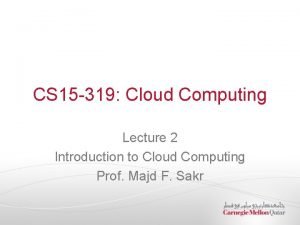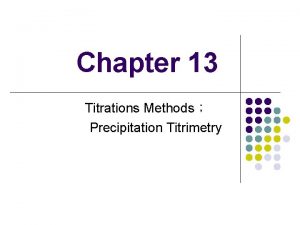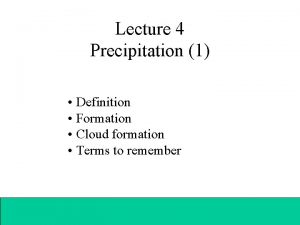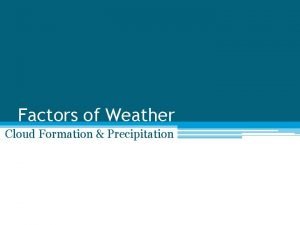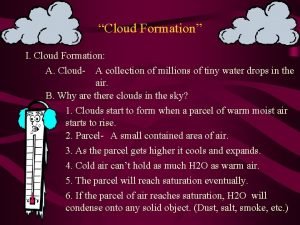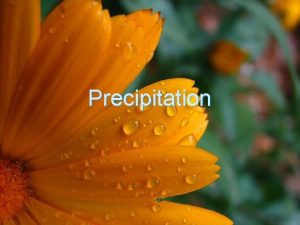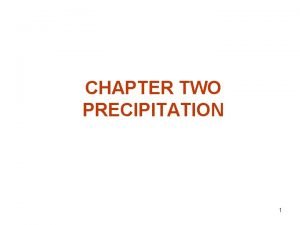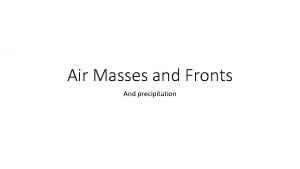Lecture 4 Precipitation 1 Definition Formation Cloud formation








- Slides: 8

Lecture 4 Precipitation (1) • Definition • Formation • Cloud formation • Terms to remember

Precipitation Definition Precipitation includes all processes that the Earth’s surface receives water from the atmosphere: rainfall, drizzle, dew and mist in liquid forms, and snow and hail in solid forms Formation Precipitation is formed in the atmosphere by condensation and coalescence of water droplets or ice crystals

Saturated water vapor pressure vs. temperature Jones (1997), Chapter 2

Terms to Remember (1) 1. Water vapour: a gaseous water molecule 2. Vapour pressure: partial pressure of the atmosphere caused by the gaseous water in the atmosphere. Pressure is the force exerted on a unit surface. The unit is Pascal (Nm-2, where the force unit N is Newton. 1 N=1 kg ms-2), or mb (=100 Pascal) 3. Saturated vapour pressure: the maximum amount of water vapour that the air can hold at a certain temperature. It is a function of temperature.

Terms to Remember (2) 4. Dew point: for a given amount of water vapour in the air, the temperature can be decreased to a point where the air becomes saturated. This point is the dew point 5. Temperature lapse rate: the rate at which the air temperature decreases with height 6. Environmental lapse rate (ELR): the temperature lapse rate in the environment surrounding an ascending or descending air parcel. It is about 6 C /km 7. Adiabatic process: air parcel ascending or descending without exchange of heat with the environment, i. e. , no mixing between the air parcel and the ambient air

Terms to Remember (3) 8. Dry adiabatic lapse rate (DALR): the decrease of air temperature with height in the ascending air parcel without water condensation. It is about 9. 8 C /km 9. Saturated adiabatic lapse rate (SALR): the decrease of air temperature with height in the ascending air parcel with water condensation. As the condensation release heat, SALR is smaller than DALR 10. Condensation level: height at which the temperature of an ascending air parcel decreases to the dew point (the air parcel become saturated). Clouds form above this level 11. Unstable air: ELR>SALP, or ELR>DALR

Cloud Formation Clouds form under two basic conditions: (1) air is saturated (2) condensation nuclei are available

Cooling-Saturation Mechanisms (1) Cooling due to lifting: (i) thermal lifting: under unstable conditions, i. e. , ELR>SALP or ELR>DALP, the air parcel is forced to lift, causing cooling as it rises to higher levels where the air pressure is lower. At lower ambient pressure, the parcel expands, resulting in cooling; (ii) Orographic lifting: lifting of air parcel can also be caused by air moving across mountain ranges; (iii) mechanical lifting: when two air masses converge (collide with each other), one of both will be lifted. These are the main causes for cloud formation. (2) Cooling due to radiation: longwave radiation emission cools the surface and then the air near the surface. This is the main cause for dew and mist formation. (3) Cooling due to advection: horizontal movement of air into a cooler air mass or over a cooler surface.
 Gravimetry steps
Gravimetry steps Co precipitation and post precipitation
Co precipitation and post precipitation 01:640:244 lecture notes - lecture 15: plat, idah, farad
01:640:244 lecture notes - lecture 15: plat, idah, farad Cloud computing lecture
Cloud computing lecture Parallel and distributed computing lecture notes
Parallel and distributed computing lecture notes Argentometric titration definition
Argentometric titration definition Computing refers to applications and services that run on a
Computing refers to applications and services that run on a Cloud integration patterns
Cloud integration patterns Public cloud vs private cloud cost analysis
Public cloud vs private cloud cost analysis



